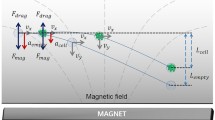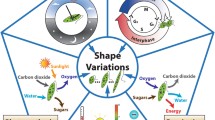Abstract
Much effort has been made to manipulate cells for many biomedical and environmental applications. However, controlling cells in efficient and sustainable ways is still an essential task to achieve in both science and engineering fields. Here, we introduced a strategic approach in which cells are autonomously sorted and separated in a fluidic system. We employed ‘self-secreted macromolecules’ from microalgae in the microfluidic devices and examined their various properties. The cell manipulation was determined depending on the intrinsic properties of the self-secreted biomolecules. The macromolecules self-produced by green algae allowed the size-based separation of cells. This self-sorting system would enable the design and fabrication of new types of biosystems such as bioreactors and pharmaceutical devices.
Graphic abstract









Similar content being viewed by others
References
Abu- Lail N, Camesano T (2003) Polysaccharide properties probed with atomic force microscopy. J Microsc 212:217–238
Amini H, Lee W, Di Carlo D (2014) Inertial microfluidic physics. Lab on a Chip 14:2739–2761
Bird RB, Armstrong RC, Hassager O (1987) Dynamics of polymeric liquids, volume 1: fluid mechanics. Wiley, New York
Bombelli P et al (2012) Surface morphology and surface energy of anode materials influence power outputs in a multi-channel mediatorless bio-photovoltaic (BPV) system. Phys Chem Chem Phys 14:12221–12229
Chan P-H, Leal L (1979) The motion of a deformable drop in a second-order fluid. J Fluid Mech 92:131–170
Cuecas A, Cruces J, Galisteo-López JF, Peng X, Gonzalez JM (2016) Cellular viscosity in prokaryotes and thermal stability of low molecular weight biomolecules. Biophys J 111:875–882
De Philippis R, Sili C, Tassinato G, Vincenzini M, Materassi R (1991) Effects of growth conditions on exopolysaccharide production by Cyanospira capsulata. Biores Technol 38:101–104
Deng S, Bai R, Hu X, Luo Q (2003) Characteristics of a bioflocculant produced by Bacillus mucilaginosus and its use in starch wastewater treatment. Appl Microbiol Biotechnol 60:588–593
Doddi SK, Bagchi P (2008) Lateral migration of a capsule in a plane Poiseuille flow in a channel. Int J Multiph Flow 34:966–986
Doi M, Edwards SF (1988) The theory of polymer dynamics, vol 73. Oxford University Press, Oxford
Donlan RM (2002) Biofilms: microbial life on surfaces. Emerg Infect Dis 8:881
DuBois M, Gilles KA, Hamilton JK, Rebers PT, Smith F (1956) Colorimetric method for determination of sugars and related substances. Anal Chem 28:350–356
Flemming H, Wingender J (2010) The biofilm matrix. Nat Rev Microbiol 8:623–633
Flemming HC, Neu TR, Wozniak DJ (2007) The EPS matrix: the “house of biofilm cells”. J Bacteriol 189:7945–7947
Hay ED (2013) Cell biology of extracellular matrix, 2nd edn. Springer, New York
Hossain AS, Salleh A, Boyce AN, Chowdhury P, Naqiuddin M (2008) Biodiesel fuel production from algae as renewable energy. Am J Biochem Biotechnol 4:250–254
Hur SC, Henderson-MacLennan NK, McCabe ER, Di Carlo D (2011) Deformability-based cell classification and enrichment using inertial microfluidics. Lab Chip 11:912–920
Kim JY, Ahn SW, Lee SS, Kim JM (2012) Lateral migration and focusing of colloidal particles and DNA molecules under viscoelastic flow. Lab Chip 12:2807–2814
Kim MJ, Youn JR, Song YS (2018) Focusing manipulation of microalgae in a microfluidic device using self-produced macromolecules. Lab Chip 18:1017–1025
Körstgens V, Flemming H-C, Wingender J, Borchard W (2001) Uniaxial compression measurement device for investigation of the mechanical stability of biofilms. J Microbiol Methods 46:9–17
Lee DJ, Brenner H, Youn JR, Song YS (2013) Multiplex particle focusing via hydrodynamic force in viscoelastic fluids. Sci Rep 3:3258
Li G, McKinley GH, Ardekani AM (2015) Dynamics of particle migration in channel flow of viscoelastic fluids. J Fluid Mech 785:486–505
Liu H, Fang HH (2002) Extraction of extracellular polymeric substances (EPS) of sludges. J Biotechnol 95:249–256
Liu Y, Fang HH (2003) Influences of extracellular polymeric substances (EPS) on flocculation, settling, and dewatering of activated sludge. Crit Rev Environ Sci Technol. https://doi.org/10.1080/10643380390814479
Magnaudet J, Takagi S, Legendre D (2003) Drag, deformation and lateral migration of a buoyant drop moving near a wall. J Fluid Mech 476:115–157
Mayer C, Moritz R, Kirschner C, Borchard W, Maibaum R, Wingender J, Flemming H-C (1999) The role of intermolecular interactions: studies on model systems for bacterial biofilms. Int J Biol Macromol 26:3–16
McCormick AJ, Bombelli P, Scott AM, Philips AJ, Smith AG, Fisher AC, Howe CJ (2011) Photosynthetic biofilms in pure culture harness solar energy in a mediatorless bio-photovoltaic cell (BPV) system. Energy Environ Sci 4:4699–4709
More T, Yadav J, Yan S, Tyagi R, Surampalli R (2014) Extracellular polymeric substances of bacteria and their potential environmental applications. J Environ Manage 144:1–25
Morris ER (1990) Shear-thinning of ‘random coil’ polysaccharides: Characterisation by two parameters from a simple linear plot. Carbohydr Polym 13:85–96
Mortazavi S, Tryggvason G (2000) A numerical study of the motion of drops in Poiseuille flow. Part 1. Lateral migration of one drop. J Fluid Mech 411:325–350
Roberts IS (1996) The biochemistry and genetics of capsular polysaccharide production in bacteria. Annu Rev Microbiol 50:285–315
Rubinstein M, Colby RH (2003) Polymer physics, vol 23. Oxford University Press, New York
Smith DE, Babcock HP, Chu S (1999) Single-polymer dynamics in steady shear flow. Science 283:1724–1727
Song HY, Lee SH, Salehiyan R, Hyun K (2016) Relationship between particle focusing and dimensionless numbers in elasto-inertial focusing. Rheol Acta 55:889–900
Stan CA, Ellerbee AK, Guglielmini L, Stone HA, Whitesides GM (2013) The magnitude of lift forces acting on drops and bubbles in liquids flowing inside microchannels. Lab Chip 13:365–376
Sutherland IW (2001) The biofilm matrix–an immobilized but dynamic microbial environment. Trends Microbiol 9:222–227
Svetličić V, Žutić V, Radić TM, Pletikapić G, Zimmermann AH, Urbani R (2011) Polymer networks produced by marine diatoms in the northern Adriatic Sea. Mar Drugs 9:666–679
Tam CK, Hyman WA (1973) Transverse motion of an elastic sphere in a shear field. J Fluid Mech 59:177–185
Whitfield C, Valvano MA (1993) Biosynthesis and expression of cell-surface polysaccharides in gram-negative bacteria. Adv Microb Physiol 35:135–246
Wingender J, Neu TR, Flemming H-C (1999) What are bacterial extracellular polymeric substances? Microbial extracellular polymeric substances. Springer, New York, pp 1–19
Wloka M, Rehage H, Flemming H-C, Wingender J (2004) Rheological properties of viscoelastic biofilm extracellular polymeric substances and comparison to the behavior of calcium alginate gels. Colloid Polym Sci 282:1067–1076
Xiao R, Zheng Y (2016) Overview of microalgal extracellular polymeric substances (EPS) and their applications. Biotechnol Adv 34:1225–1244
Zhang J (2015) Particle inertial focusing and separation in serpentine microchannels: mechanisms and applications. University of Wollongong, Wollongong, Australia
Zhou K, Hu Y, Zhang L, Yang K, Lin D (2016) The role of exopolymeric substances in the bioaccumulation and toxicity of Ag nanoparticles to algae. Sci Rep 6:32998
Acknowledgements
This work was supported by GRRC program of Gyeonggi Province (GRRC Dankook2016–B03). In addition, this research was supported by Basic Science Research Program through the National Research Foundation of Korea (NRF) funded by the Ministry of Education (2018R1D1A1B07049173) and by the Korea government (MSIT) (No. NRF-2018R1A5A1024127). Korea Institute for Advancement of Technology (KIAT) grant funded by the Korea Government (MOTIE) (P0002007, The Competency Development Program for Industry Specialist). The authors are grateful for the supports.
Author information
Authors and Affiliations
Corresponding authors
Ethics declarations
Conflict of interest
The authors declare the following competing financial interest(s).
Additional information
Publisher's Note
Springer Nature remains neutral with regard to jurisdictional claims in published maps and institutional affiliations.
Electronic supplementary material
Below is the link to the electronic supplementary material.
Movie S1. Separation of Sphaerocystis schroeteri the self-secreted macromolecules with a flow rate of 400 μl/hr (Re = 0.122, Wi = 88.9). The trajectories of different size cell were observed at the outlet. (AVI 1569 kb)
Rights and permissions
About this article
Cite this article
Kim, M.J., Youn, J.R. & Song, Y.S. Autonomous cell sorting using self-secreted macromolecules. Microfluid Nanofluid 23, 115 (2019). https://doi.org/10.1007/s10404-019-2282-2
Received:
Accepted:
Published:
DOI: https://doi.org/10.1007/s10404-019-2282-2




